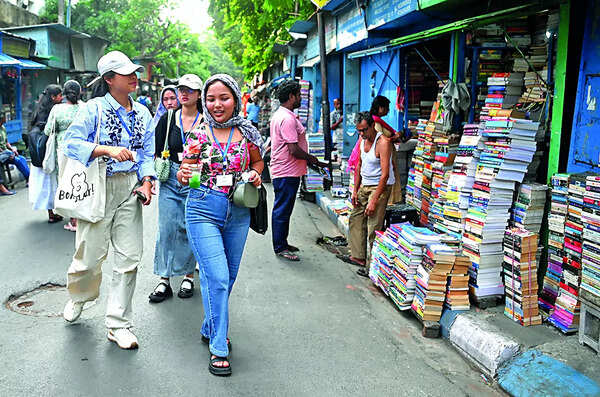
Boi Para college street: The heart of Kolkata’s literary and cultural heritage | – The Times of India
It begins with the creak of an old hand-pulled rickshaw, somewhere near Bowbazar. You hop in and ask the rickshaw-wallah to take you to College Square. He turns, slightly confused, and asks, “Madho Babu ka Talao?” The name lingers like a forgotten song. That’s what it was once called — the large water body at College Square was once the private pond of Madhab Dutta, a local landed gentry in what was then a sleepy hamlet.

1880 CU Senate Hall, Hare School, Presidency College
What stands today is not just a pond, but a history-soaked epicentre of knowledge and culture — College Street, the revered Boi Para or “Book Town” of Kolkata. This vibrant stretch of heritage, intellect, resistance, and nostalgia is more than a street; it’s a cultural bloodstream where books breathe and ideas are born.
Where It All Began
The name “College Street” dates back to 1817 with the founding of Hindu College, the brainchild of David Hare, a Scottish watchmaker turned education reformer. He envisioned a liberal education for Bengal’s boys and laid the cornerstone of Bengal’s modern education system. To fulfil his dream, he bought land from Madhab Dutta and built a cluster of institutions — Hare School, Presidency College, and later the University of Calcutta, all of which eventually ringed the area.

In the same year of the foundation of Hindu College, Hare established the School Book Society, planting the seeds of what would become Boi Para — publishing, printing, and selling books in Bengali and English. “David Hare was refused burial in Christian cemeteries for being a non-believer. It was the people of Kolkata who collected money and built his tomb at College Square,” says Dr Shankar Nath, a physician and city historian.
A Marketplace of Minds
College Street today is a veritable mecca for bibliophiles. From glossy bestsellers to rare, yellowing editions hidden in unassuming stalls, this is the world’s largest second-hand book market and the second largest book market overall. The history of Bengal’s printing revolution began a few kilometres away in Chitpur’s Garanhata nearly 60-70 years earlier. It was here, under the shade of now-vanished banyan trees, that Bengali-owned presses first mushroomed in the late 18th century. Known as Battala publications, they produced everything — from almanacs to erotic fiction — making books available and affordable for the masses.

In 1857, Reverend James Long recorded over 46 Bengali presses and half a million books printed for sale in Kolkata. The famed Battala Presses soon became the soul of vernacular literature, until lithographic technology slowly edged them out. Yet, their legacy lives on — in academic archives, global museums, and the very spirit of Boi Para.
Coffee, Conversations, and Counterculture
At the heart of Boi Para is the legendary Coffee House, formerly Albert Hall, built in 1876. Once the site of the first Indian Medical School, it evolved into a political, literary, and social hub. From Netaji Subhas Chandra Bose to Satyajit Ray, from Shakti Chattopadhyay to Amartya Sen, every table here once echoed with revolutionary whispers, literary debates, and philosophical discourse.

“Dipak Banerjee, father of Nobel laureate Abhijit Banerjee, was a regular here. We’d talk books for hours,” recalls Sachindranath Bhattacharya, former Museology professor at Calcutta University. The Coffee House’s adda culture inspired Manna Dey’s iconic song, ‘Coffee House er shei adda ta aaj aar nei…’ — a melancholic anthem for generations.
A Literary Living Room
The alleys of Boi Para hum with greetings like “Ki go Chatterjee babu? Onekdin dekha nei toh!” as customers revisit their favourite haunts. Bookstores here are not just shops — they are living rooms of readers, guardians of rare finds and keepers of intellectual inheritance. Take Dasgupta & Co, a heritage bookstore since 1889, or Deb Sahitya Kutir, famous for Bengali comics and children’s literature. College Street is where books are still bartered, memories still preserved.

Historian Prof Suranjan Das fondly recalls his professors hunting for hidden gems at old book stalls. “Each discovery was a eureka moment,” he says, though he laments today’s shift toward exam guides and notes. “The pursuit of knowledge,” he sighs, “has been overtaken by the race for jobs. AI might be the last nail in the coffin.”
A New Chapter Unfolds
But is Boi Para really a relic of the past? Tridib Chattopadhyay, president of the Publishers and Booksellers Guild, strongly disagrees. “Every year, our book fair breaks sales records. There’s still a hunger for stories.”
Sudhanshu Dey, publisher and Guild secretary, sees a thriving new wave. Independent publishers like Dhyanbindu are making waves with fresh voices, radical ideas, and dynamic content. “We had to accommodate over 100 new publishers this year alone,” he says.
Print-on-demand has revolutionised the trade. “We now test print runs of just 100 copies. If demand rises, we print 1,000 more,” says Pritam Sengupta of Read Bengali Books. The new wave of publishing in Boi Para has taken firm root, particularly in the south and east flanks of College Square — an emergence that gained momentum during the pandemic years.
Where Pages Meet Plates
No visit is complete without savouring the local cuisine. From Putiram’s famed sweets to Paramount’s serbets to street stalls serving kachoris, chops, and rolls, the food here is steeped in nostalgia. It’s not just sustenance — it’s part of the culture. Boi Para is not just a street. It is a chronicle. A place where knowledge is sold by the kilo, ideas percolate in coffee cups, and time slows to the turning of a page. Whether you’re in search of an elusive first edition or simply walking through history, College Street will never fail to impress — or inspire.
And maybe, just maybe, if you ask the rickshaw-wallah again, he’ll nod and say, “College Square? Haan, Madho Babu’r Talao… cholen.” And your journey begins.